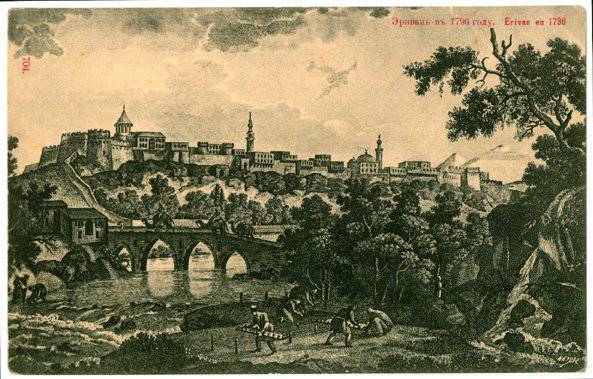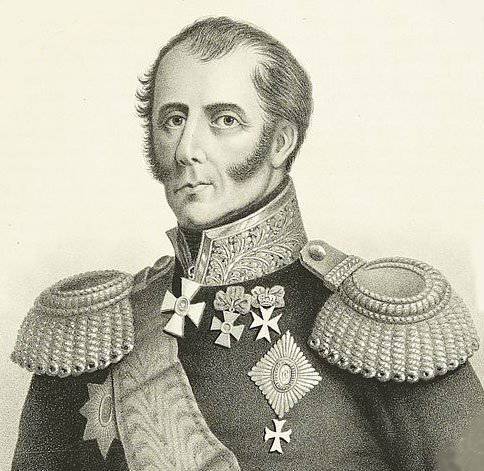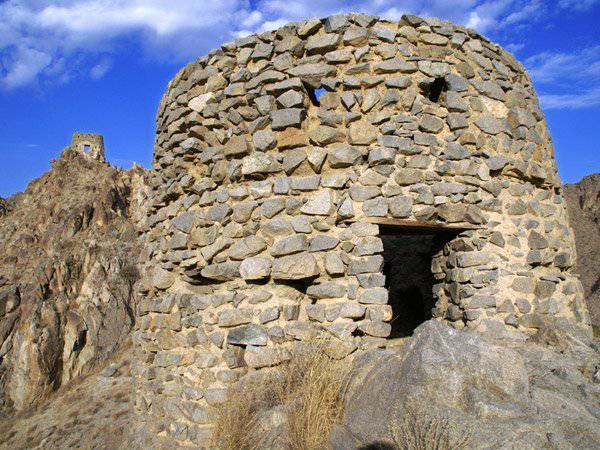Siege of Erivan. The feats of "miracle heroes" Kotlyarevsky
Campaign 1808 of the year. Siege of Erivan
The 1808 campaign of the year was less successful. Resumed fighting with the Persians. In Persia, the help of French instructors led to the formation of a new regular army and artillery. At the same time, Tehran did not want to conclude a peace agreement with St. Petersburg and recognize the new lands for Russia. In the Erivan Fortress, great forces again concentrated. Then Gudovich, who, after defeating the Turkish army on the Arpachai River, received the rank of Field Marshal, decided to warn the enemy and moved the troops to the Erivan khanate.
The problem was that the number of Russian troops in the South Caucasus was still small. Gudovich had only 6 thousand soldiers. The troops had high combat capability, but were few in number. The hike began in September 1808. Russian troops calmly passed through Shuragel region populated by Armenians. The Persian cavalry tried to block the road, but when the Russian troops began to turn around, retreated. Without a fight, the well-fortified Echmiadzin Monastery was occupied. Gassan-bek, who ruled in Erivan, fled from the city, not hoping to defend him. He appointed his brother as commander of the garrison. Russian troops camped on the banks of the river Zangi. As during the siege of Erivan by the Tsitsianov detachment in 1804, Gudovich did not have enough troops to completely blockade the fortress. Taking advantage of this, the Persians immediately made a strong sortie. However, the grenadier battalion overturned the Persians, and they hurried to hide behind the walls of the fortress.
Having arranged the troops in the camp, Gudovich identified two separate small detachments. The detachment under the command of Semen Andreevich Portnyagin stood up at the fords across the Araks River, from where the Persian army could appear and strike Gudovich troops in the rear. Another detachment under the command of Petr Fedorovich Nebolsin went along the bank of the Araks to the south and occupied 1 in November on Nakhchivan.
This decision was very timely. Portnyagin, having at his disposal only one Narva Dragoon Regiment and some infantry with 4 guns, twice repelled the blows of the Persian cavalry, which was trying to break through to Erivani. Nebolsin had a brilliant deal with the Persians under the command of the heir to the Persian throne, Abbas Mirza, defeated the Persian troops and did not allow them to hit the Russian lands through the Nakhchivan khanate.
While the Russian barriers held back the Persian army on the Araks River, the situation with besieged Erivan did not change. Gudovich, like Tsitsianov before him, did not have large-caliber siege artillery, and the enemy knew this, not intending to capitulate. The many thousands garrison of the Erivan fortress had no shortage of supplies and did not leave the stronghold, not wanting to risk in open battle. To this, Persian assistance was close. Persian scouts regularly made their way into the fortress and supported the hope of the garrison to the assistance of the army of Prince Abbas Mirza.
Gudovich installed an artillery battery on the bank of Zangi, which consisted of field guns and three mortars, repulsed by the Ottomans last year. The siege battery conducted a concentrated fire on a certain section of the fortress wall in order to create a breach for the assault. Small gaps were periodically made in the wall, but at night they were quickly sealed with stone and logs. Powerful guns to break a wide gap was not. The enemy also regularly fired cannons and rifles at the Russian troops. The Persians were most afraid of the night assault, so with the onset of the night they put up large guards. The reinforced patrols regularly fired at the Russian camp at night, and the sentinel threw illuminations from the walls — burning torches to illuminate the approaches to the fortress.
Field Marshal Gudovich was a great specialist in the assault of fortresses and hoped to wear down the enemy garrison. Russian troops regularly arranged false alarms for the Persians. In response, the Persians began a fierce firing, and throwing dozens of torches from the walls. However, this Persian firing Russian troops did not cause any harm. Persians did not differ accuracy.
It is possible that such a tactic would soon bring success. However, in the middle of November, in the mountains, at this time, snow fell extremely rarely and fell sharply cold. We had to go to the storming of the fortress or leave. There was almost no warm clothing among the troops, and the connection with Georgia on mountain roads deteriorated sharply, which threatened with hunger and lack of ammunition. The stockpiles of the gunners were already running out, and there was no supply from Tiflis. Gudovich decided to take a chance and ordered an assault on November 17. They decided to strike the main blow through a hole that the artillery punched in the daytime, the Persians usually sealed it by morning. In the assault was to take part several columns. A reserve remained in the camp, which was to join the battle when the advanced forces would clear the block of stones and logs and open the gates.
Russian troops were able to unobtrusively approach the fortress at a distance of half a gunshot. However, the sentries did not sleep, and during one of the torch throws, they noticed Russian assault columns approaching in complete silence. The first sentry who noticed the enemy was fired from a gun. Therefore, the alarm in the fortress raised in a timely manner. When the Russian troops went to storm, they were met by a real barrage of rifle fire and gunfire.
The main assault column was not successful. Her commander, brave major Simonovich, at the beginning of the attack received a heavy wound and was out of action. There was no full replacement, and the attacking troops could not get through to the gaps. In addition, as it turned out later, apparently, the Persians, through their spies, heard about the possibility of a close assault and, having driven a large number of citizens, by the time of the assault they had covered almost the entire breach to the very top.
One of the assault columns could make its way to the wall. Soldiers on assault ladders climbed to the wall, and a bloody hand-to-hand fight ensued. However, this time the Persians were not inferior in fortitude to the Russian soldiers. The Persians stood to death and pulled up to the dangerous place all available free forces. Gudovich sent a reserve to this site, but he could not change the outcome of the battle. As luck would have it, in this battle, almost all the officers dropped out one by one. The slaughter on the wall was half the night, but the Russian troops couldn’t go further with bayonets and butts. In a narrow area, the Persians had a numerical superiority and were able to contain the offensive outburst of the Russian column. In other areas, Russian columns could not climb the wall, and the Persians could focus on one area.
Seeing that the assault failed and in order not to incur large losses, Gudovich recalled the troops. During the night of the battle, 800 people were killed or injured. For such a small detachment it was a great loss. I had to accept failure. The military council decided to lift the siege and return to Georgia. The defensive detachments of Portnyagin and Nebolsin were returned to the camp, and the troops marched back. The return trip was difficult. Frost and heavy snow in the mountains made it difficult to move along the mountain paths. Nobody pursued the leaving Russian troops, the Persian army missed the right time to attack in Georgia. In addition, the Persians remembered the crushing defeat of the Turkish army under Yusuf Pasha in 1807.
Thus, although the Caucasian commander Gudovich could not take Erivani, he decided the main strategic task in the 1808 campaign of the year. Field Marshal General foiled the plan of the Persian command to invade Georgia. Russian troops struck a preemptive strike on the enemy, and the entire campaign was fought on foreign territory.
On the way back to Tiflis, Count Ivan Gudovich fell seriously ill and lost sight in one eye. Difficult years affected the elderly General Field Marshal. Gudovich, at the beginning of 1808, filed his resignation, but a positive response came only in March, 1809.
Russian troops in the Caucasus were headed by Alexander Petrovich Tormasov. The new commander showed tireless energy, the ability to direct the actions of his troops and the ability to choose performers. The closest associates of Tormasov - Kotlyarevsky, Lisanevich and Simanovich - inflicted a number of defeats on the Turks, Persians and local Caucasian feudal rulers. Poti fortress was captured, which excluded the influence of the Turks on Abkhazia and Imeretia. Suppressed the uprising in Dagestan. Dmitry Lisanevich, whose name inspired fear in the native inhabitants (they called him “Delhi-Major”, that is, a mad major), took a prominent part in the pacification of Imeretiya and the Cuban Khanate. Fyodor Simanovich reassured Imeretia, abolishing the throne of the Imeretian kingdom (Imereti King Solomon joined against Russia). Then he defeated the Turkish troops in the Khani gorge and the passage of the Majas-Tskhali and, joining with Tormasov, participated in the siege of Akhaltsikhe. Simanovich also pacified the rebellion in Kakheti.

Further fighting. Feats Kotlyarevskogo
In the fighting with Persia came a new pause. In the 1809 campaign of the year, fighting was conducted mainly on the Black Sea coast. Unsuccessful negotiations were conducted with the Persians, and Turkish troops were gradually forced out of the Transcaucasus. At that time, a new talented military leader, Peter Stepanovich Kotlyarevsky, emerged from the environment burned by the sun and frost and Russian Caucasian troops soaked in gunpowder.
Peter Stepanovich was born in 1782 in the family of a village priest, he studied at the Kharkov Theological School and had to follow in his father's footsteps. However, the case has changed his life. At the time of his father’s house, the commander of the 4 battalion of the Kuban Eger corps, lieutenant colonel I., stopped for a time. Lazarev, who was heading to Mozdok. Lazarev liked a smart and lively boy and invited his parents to give him military service. In 1794, the young man enlisted in the rank and file of the Kuban Eger building, in the 4 battalion commanded by Lazarev. The lieutenant colonel took care of Kotlyarevsky’s training and military education. Soon he became a sergeant. In 1796, the Persian campaign began under the command of V.A. Zubova. In the storming of Derbent, Sergeant Kotlyarevsky, in his own words, for the first time "heard the whistle of enemy bullets." In the incomplete 15 years, Peter became a warrior.
In 1799, he was promoted to second lieutenant and became Lazarev's adjutant, who was already Major General and Chief of the 17 Regiment of Chasseurs. 1800, Kotlyarevsky took part in repelling the invasion of Lezgins and received the rank of captain. After the tragic death of General Lazarev (he was stabbed to death in the Georgian queen Tamara), Tsitsianov offered Kotlyarevsky to become his adjutant, but the officer preferred military service. He became the commander of the company 17 th Chasseur Regiment.
The war with Persia brought Kotlyarevsky the glory of an invincible leader. He distinguished himself during two assaults of Ganja (1803 in December and 1804 in January). In the first assault, Pyotr Stepanovich and his rangers took the fordstadt (suburb) and ensured the advance of the main forces. For the bravery shown in this battle, the officer was awarded the Order of St. Anna III degree and received the rank of major. In 1805, Kotlyarevsky and his company in the squad of Colonel Karyagin participated in a famous battle, when several hundred Russian soldiers successfully opposed the whole Persian army.
Despite two new wounds, Kotlyarevsky soon took part in an expedition against the Baku Khanate, and also fought against the Persians. In 1807, Peter Stepanovich was promoted to colonel. In 1808, he took part in the campaign on Erivan, as part of the Nebolsin's squad, smashed the army of Persian Prince Abbas-Mirza in the village of Karabab and participated in the capture of Nakhichevan.

Hero of the Russian-Persian War 1804-1813 Petr Stepanovich Kotlyarevsky
In 1809, Peter Kotlyarevsky was entrusted with the defense of Karabakh. The war took a protracted character, in 1810, Persia entered into alliances with Turkey and England. The Persians have repeatedly considered making peace, but the British did not want this. In Tehran, the British ambassador Sir Hartford Jones struggled to revive the dying war. The British convinced Prince Abbas-Mirza, who was a Westerner and unbridled admirer of Napoleon, trying to modernize Persia in a European way, breaking the alliance with France. Hundreds of British military advisers arrived in Persia, unloaded 30 thousand guns, 12 guns, and cloth on their uniforms for the new Persian regular army. The British promised money for three years of the war, to form 50 thousand. army and create a persian military in the Caspian flotilla. The new British ambassador, Sir Gore Uzley, promised that the Persians would return Georgia and Dagestan. New military advisers arrived with the new ambassador, and he brought money for three years of the war. The Persian Shah Feth-Ali, painfully loving gold, could not resist, and continued the war. In fact, for three years, London leased the Persian army and foreign policy.
In May, 1810, 30-thous. Abbas-Mirza's army invaded Nakhichevan. The Persians planned to enter Georgia through Karabakh. However, a small detachment Kotlyarevskogo stopped the enemy. Having only about 300-400 bayonets, without guns, he decided to take the impregnable nature and besides strongly fortified fortress Migri (Meghri). In fact, these were the Transcaucasian Thermopylae, and, keeping them behind them, it was possible to block the path of the whole army. Meghri's garrison consisted of 2 thousand regular Persian infantry (sarbazov) with artillery (7 batteries). The approaches to the fortress were covered by abutments that defended 200 infantrymen-sarbazov. Kotlyarevsky deceived the enemy. He did not attack Migri from the side from which the Persians were waiting. Russian soldiers walked around Migri from the rear along narrow mountain paths. Then Kotlyarevsky made a false attack from one front, and attacked the fortress from another. Russian soldiers suddenly attacked the central fortifications of the Persians and after three days of fighting, 17 (29) of June, the Russian soldiers took Migri. The Persians lost more than 300 people, the losses of Russians - 35 people.
Then, for two weeks, Kotlyarevsky’s detachment held back attacks from the Persian army of Abbas-Mirza. As a result, the Persian commander removed an unsuccessful siege and moved back to the border. Kotlyarevsky made a night raid and 6 (18) July in a battle on the Arax River defeated the Persian army. In this battle, Kotlyarevsky was wounded for the fifth time. For courage was awarded the Order of St.. George 4 degree and a gold sword with the inscription "For courage." Soon he was appointed commander of the Georgian (Caucasian) Grenadier Regiment. About the secret of his victories, Peter Kotlyarevsky said: “I think coldly, but I act hotly”.
In the 1811 campaign of the year, the operations of a small detachment of Kotlyarevsky again saved Georgia from enemy invasion. Failing to succeed in Karabakh, the Persian command decided to act through Turkish territory. Persian-Turkish troops planned to strike at the Russian possessions by Akhaltsikha. Kotlyarevsky was instructed to stop the enemy offensive. The Russian commander, in order to disrupt the plans of the enemy, decided to seize the fortress of Akhalkalaki.
Conducting their grenadiers, the Cossack battalion of the 46 th Jäger Regiment and the 100 Don Cossacks, with assault ladders, Kotlyarevsky for three days overcame the mountains along goat paths and through the valleys to the waist in the snow. Russian troops appeared at the Turkish fortress, as Suvorov taught, like snow on the head. With the onset of darkness the Russians, in three columns, went to storm. The sentries noticed Russian troops only when they had already appeared on the walls. Earlier than the enemy managed to recover, Kotlyarevsky's grenadiers were already sitting on their cannons! After an hour and a half battle, the Turkish garrison capitulated. Russian trophies were 16 guns, 2 banner and 40 pounds of gunpowder. The enemy losses amounted to several hundred people, the Russians killed 27 people. For this brilliant success, the banners of St. George's Grenadier Regiment welcomed the battalions of the Georgian Grenadier Regiment, and Kotliarevsky was promoted to major general. These defeats, as well as the fact that the Ottoman Empire began peace negotiations with Russia and left the war, made Persia think again about peace.

Migri Fortress (Megri)
To be continued ...
Information